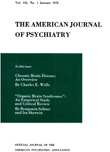THE COMMUNICATION OF SUICIDAL INTENT: A STUDY OF 134 CONSECUTIVE CASES OF SUCCESSFUL (COMPLETED) SUICIDE
Abstract
1. A study of the communication of suicidal ideas by 134 consecutive suicides has been done by means of systematic interviews with family, in-laws, friends, job associates, physicians, ministers, and others a short time after the suicide.
2. Two striking findings were that over two-thirds (69%) of the suicides had communicated suicidal ideas and that 41% had specifically stated they intended to commit suicide. In the majority of instances, the suicidal communications were of recent onset (months), repeatedly verbalized, and expressed to many persons.
3. Another striking finding was that 98% of these persons were probably clinically ill prior to their suicides.
4. The frequency of expression of suicidal ideas was not significantly related to age, sex, marital state, religion, whether living alone or not, clinical diagnosis, occupational status, income, or education. Chronic alcoholics had a somewhat greater tendency than the other diagnostic groups to make the specific statement that they intended to commit suicide.
5. The communication of suicidal ideas was analyzed as a general system of communication with reference to experimental psychological studies.
Access content
To read the fulltext, please use one of the options below to sign in or purchase access.- Personal login
- Institutional Login
- Sign in via OpenAthens
- Register for access
-
Please login/register if you wish to pair your device and check access availability.
Not a subscriber?
PsychiatryOnline subscription options offer access to the DSM-5 library, books, journals, CME, and patient resources. This all-in-one virtual library provides psychiatrists and mental health professionals with key resources for diagnosis, treatment, research, and professional development.
Need more help? PsychiatryOnline Customer Service may be reached by emailing [email protected] or by calling 800-368-5777 (in the U.S.) or 703-907-7322 (outside the U.S.).



